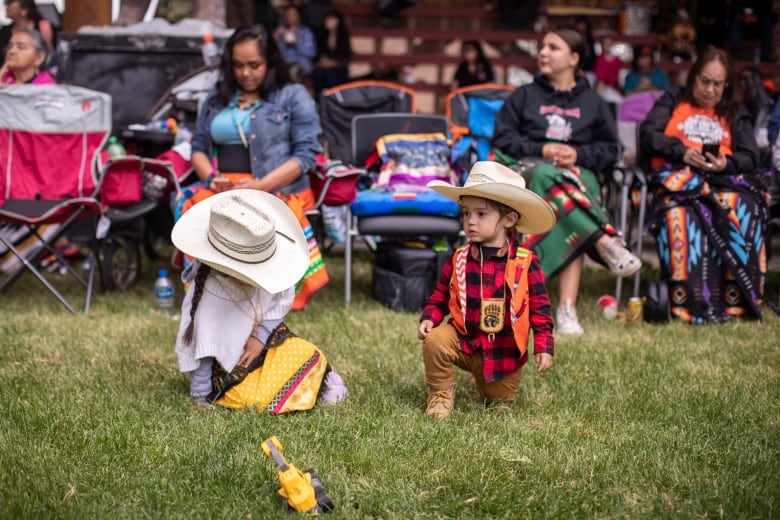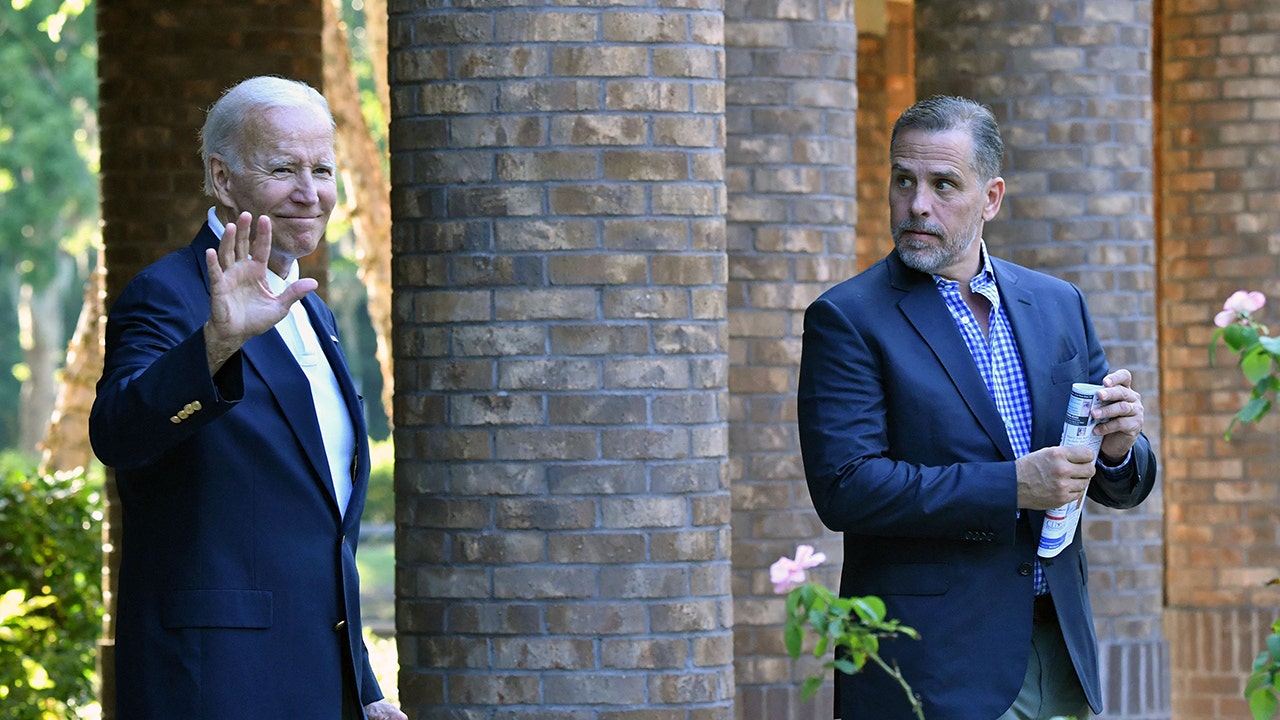Hundreds gather for memorial marking 1 year since discovery at Kamloops residential school
WARNING: This story contains distressing details.
As the sun poked out from behind the mountains in Kamloops, B.C., early Monday morning, dozens of people gathered at the Tk̓emlúps Powwow Arbour to mark the one-year anniversary of the announcement that potential unmarked graves had been found at the site of the former Kamloops Indian Residential School.
The ceremony by the Tk̓emlúps te Secwépemc First Nation was the first of many Monday to honour the children whose lives were lost while being forced to attend residential school, whom the nation has come to refer to as Le Estcwicwe̓y̓ — The Missing.
By mid-morning, hundreds of people had arrived.
Some women donned ribbon dresses and other regalia, while others wore orange shirts — a symbol of solidarity with survivors and their families — to mark the day. Birds chirped as traditional drumming and powerful song rang out, while the smell of cleansing sage filled the air.

Renae Lindley, a member of the Syilx Nation, travelled from Merritt to be part of the memorial along with her two-year-old son, Raiden, and her four-year-old niece, Lexani.
“We are here in support of a lot of our family members, from both sides, who have gone to residential school,” she said. Five of her family members were forced to attend residential school, including her mother, who attended for three years.
“It’s a lot of emotion. You can feel the emotion; it’s very, very heavy.”

Elders she’s spoken with are relieved, but Lindley, 35, said it’s “almost like they’re waiting for more” news about findings at residential schools.
Gov. Gen. Mary Simon told the crowd she struggled to find the words to express her horror and pain as she walked the grounds of the nearby residential school.
“It’s unimaginable that a place of learning could be so cruel,” she said.
Though the morning was sombre as elders and leaders spoke about Canada’s dark legacy of residential schools, Tk̓emlúps Kukpi7 (Chief) Rosanne Casimir’s message focused on hope and empowerment.
“Real reconciliation starts with good relationships and partnerships and being there through the best and worst of times,” she told the crowd at the arbour, noting support from the City of Kamloops and other levels of government.
“My hope is for reconciliation and I’m going to hold on to that hope.”
Prime minister makes appearance
Prime Minister Justin Trudeau arrived in Kamloops late Monday afternoon to meet with Casimir and council members and to attend an evening ceremony.
Trudeau was followed by a large group of memorial attendees who chanted and pounded drums as he stopped in the stands, talking face-to-face with people and often exchanging hugs with others.
“We have so much more to do,” Trudeau was overheard saying to an elderly woman who he spoke with and hugged.
BREAKING: Prime Minister <a href=”https://twitter.com/JustinTrudeau?ref_src=twsrc%5Etfw”>@JustinTrudeau</a> is heckled at a memorial ceremony on the Tk̓emlúps te Secwépemc First Nation in British Columbia. Trudeau is at a ceremony to mark the 1 year anniversary of the discovery of potential unmarked graves at a former residential school site <a href=”https://t.co/0bI0QeLiqL”>pic.twitter.com/0bI0QeLiqL</a>
—@NEWSneil
Others did not appear as friendly, chanting, “Canada is all Indian land,” and, “We don’t need your Constitution.”
Trudeau told the crowd he hears their concerns.
“Healing is not easy,” he said.
“It’s a journey. And it takes time. And everyone has their own pace. And we will be there with you every step of the way.”

Since the findings, the federal government has committed more than $320 million to residential school site searches and support for survivors and their families, although Minister of Indigenous-Crown Relations Marc Miller has said that amount is “likely not enough.”
One year since findings released
Preliminary information obtained through ground-penetrating radar in May 2021 showed there could be as many as 215 unmarked children’s burial sites near the school, though specialist Sarah Beaulieu later said she suspects the number could be much higher as only a small portion of the site was surveyed.
On May 27, the First Nation shared the findings with the world.

For Indigenous people across the country, the announcement came as no surprise, as the abuses experienced at residential schools have been shared and detailed in oral histories for decades.
“We honour those survivors and our intergenerational survivors that carried the truths…. They have been through so many challenging and emotional, painful, retraumatizing triggers this past year,” Casimir said Monday.
“Far too many felt like it was a wound being reopened and that painful legacy of the residential school came flooding back.”

The National Centre for Truth and Reconciliation (NCTR) has said about 4,100 children died at residential schools in Canada, but that the actual total is much higher.
According to the Truth and Reconciliation Commission, a large number of Indigenous children who were forcibly sent to residential schools never returned home.
The Kamloops Indian Residential School ran from 1890 to 1969, when the federal government took over administration from the Catholic Church to operate it as a residence for a day school, until it closed in 1978.
As many as 500 children from First Nations communities across B.C. and beyond would have been registered at the school at any given time, according to the NCTR.
In January, the government struck a deal with the NCTR to hand over thousands of documents relating to residential schools.

Casimir said further investigation is required at the site. Other communities, including the nearby Williams Lake First Nation, have taken on searches of their own at residential school sites on their respective territories.
WATCH | Memorial marks one year since discovery of suspected unmarked graves at former Kamloops Indian Residential School:
WARNING: This story contains distressing details. Tk̓emlúps te Secwépemc First Nation held ceremonies on Monday to mark the one-year anniversary of the announcement that potential unmarked graves had been found at the site of the former Kamloops Indian Residential School.
Pope, Queen asked to apologize
Pope Francis has confirmed plans to visit Canada in July, and although he won’t stop in Kamloops, he is expected to make a formal apology to survivors and their families on behalf of the Church.
On Monday, Casimir told the crowd she was disappointed the Pope doesn’t plan to stop in Kamloops, but said she remains hopeful there might be a change of plans.
“It matters and your truths matter…. All of us in British Columbia, we also matter,” she said.

Following a meeting with Prince Charles on Wednesday, Assembly of First Nations Chief RoseAnne Archibald called on the Queen to apologize for the Crown’s role in the harm perpetrated by the Canadian government in her name, including the trauma caused by “institutions of assimilation and genocide in Canada.”
WATCH | One year after possible graves were detected in Kamloops, B.C., First Nations activist Cindy Blackstock says public attention to injustices has declined:
A year after possible unmarked graves detected at former Kamloops residential school site, First Nations activist Cindy Blackstock says public attention to injustices has declined.
Support is available for anyone affected by their experience at residential schools or by the latest reports.
A national Indian Residential School Crisis Line has been set up to provide support for former students and those affected. People can access emotional and crisis referral services by calling the 24-hour national crisis line: 1-866-925-4419.
Do you have information about unmarked graves, children who never came home or residential school staff and operations? Email your tips to CBC’s new Indigenous-led team investigating residential schools: [email protected].






